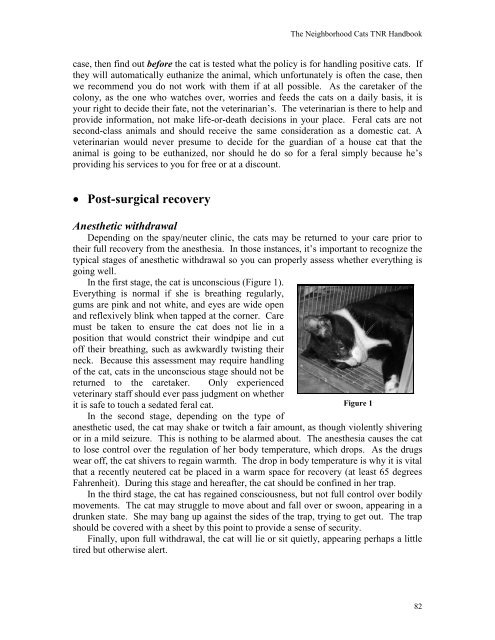Create successful ePaper yourself
Turn your PDF publications into a flip-book with our unique Google optimized e-Paper software.
The <strong>Neighborhood</strong> <strong>Cats</strong> <strong>TNR</strong> <strong>Handbook</strong><br />
case, then find out before the cat is tested what the policy is for handling positive cats. If<br />
they will automatically euthanize the animal, which unfortunately is often the case, then<br />
we recommend you do not work with them if at all possible. As the caretaker of the<br />
colony, as the one who watches over, worries and feeds the cats on a daily basis, it is<br />
your right to decide their fate, not the veterinarian’s. The veterinarian is there to help and<br />
provide information, not make life-or-death decisions in your place. Feral cats are not<br />
second-class animals and should receive the same consideration as a domestic cat. A<br />
veterinarian would never presume to decide for the guardian of a house cat that the<br />
animal is going to be euthanized, nor should he do so for a feral simply because he’s<br />
providing his services to you for free or at a discount.<br />
• Post-surgical recovery<br />
Anesthetic withdrawal<br />
Depending on the spay/neuter clinic, the cats may be returned to your care prior to<br />
their full recovery from the anesthesia. In those instances, it’s important to recognize the<br />
typical stages of anesthetic withdrawal so you can properly assess whether everything is<br />
going well.<br />
In the first stage, the cat is unconscious (Figure 1).<br />
Everything is normal if she is breathing regularly,<br />
gums are pink and not white, and eyes are wide open<br />
and reflexively blink when tapped at the corner. Care<br />
must be taken to ensure the cat does not lie in a<br />
position that would constrict their windpipe and cut<br />
off their breathing, such as awkwardly twisting their<br />
neck. Because this assessment may require handling<br />
of the cat, cats in the unconscious stage should not be<br />
returned to the caretaker. Only experienced<br />
veterinary staff should ever pass judgment on whether<br />
it is safe to touch a sedated feral cat.<br />
In the second stage, depending on the type of<br />
Figure 1<br />
anesthetic used, the cat may shake or twitch a fair amount, as though violently shivering<br />
or in a mild seizure. This is nothing to be alarmed about. The anesthesia causes the cat<br />
to lose control over the regulation of her body temperature, which drops. As the drugs<br />
wear off, the cat shivers to regain warmth. The drop in body temperature is why it is vital<br />
that a recently neutered cat be placed in a warm space for recovery (at least 65 degrees<br />
Fahrenheit). During this stage and hereafter, the cat should be confined in her trap.<br />
In the third stage, the cat has regained consciousness, but not full control over bodily<br />
movements. The cat may struggle to move about and fall over or swoon, appearing in a<br />
drunken state. She may bang up against the sides of the trap, trying to get out. The trap<br />
should be covered with a sheet by this point to provide a sense of security.<br />
Finally, upon full withdrawal, the cat will lie or sit quietly, appearing perhaps a little<br />
tired but otherwise alert.<br />
82


